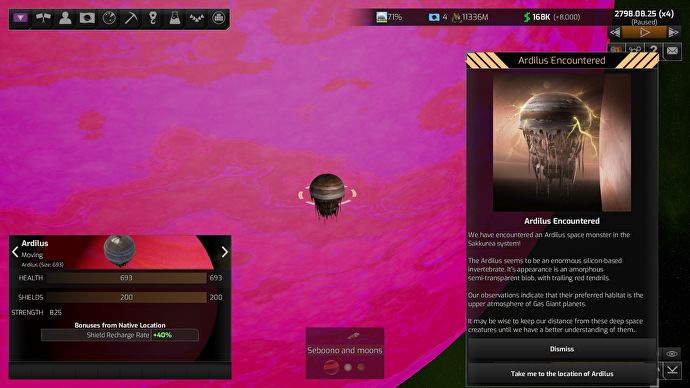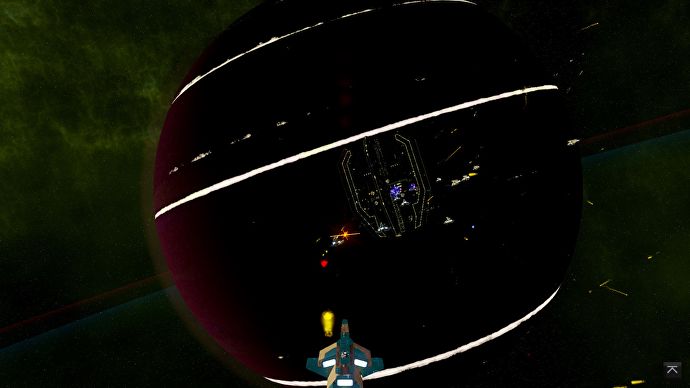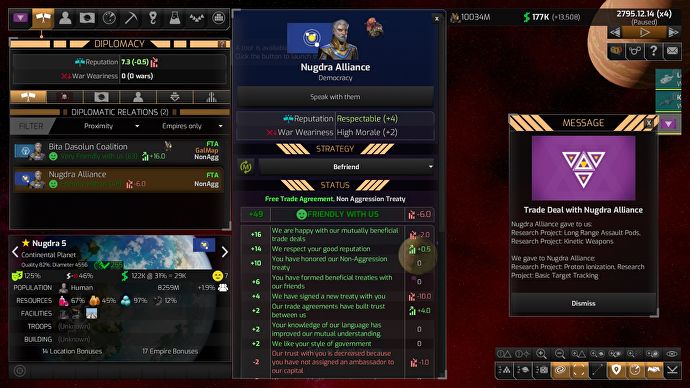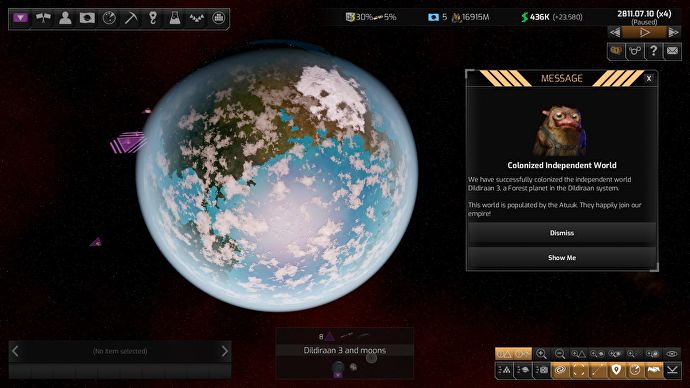Distant Worlds 2 review in progress: two steps forward and one back

I still don’t know where to start.
Distant Worlds 2 is huge. Even when familiar with the original, even after our preview last month, there’s way too much going on to review it comprehensively within a mere few days. But in the spirit of the ancient ones, I can share a review-in-progress of what I’ve seen so far.
Alright, alright. Partly it’s because it’s a long game. But it’s also because I really want to keep playing.
Distant Worlds 2 is, in the plainest terms, a strategy game about building a space empire that will dominate an entire galaxy. Those galaxies are comprised of thousands of stars, the dot of each often orbited by multiple planets, moons, and asteroid fields. Many of those in turn contain resources that you must detect, mine, and ship back to populated worlds, to trade or turn into components for the ships and space stations that impress your will upon everyone else.
In the gamest terms, DW2 is a 4X, then. I often bemoan those as stagnant, putting me in a strange spot for this one because it is in many ways a classic 4X, but goes about things completely differently to most. Crucially, every ship and station is built directly from components of your choosing, themselves made from specific resources you’ve mined or imported. This has several effects, but most crucially it makes economics about more than just cash, and turns the usual formlessness of space into a complex geopolitical concern. A mine isn’t good because it makes your money go up, it’s good because it’s the only source of osalia stone anyone nearby knows about. Without it, you can’t build anything that uses osalia stone. With it, you can, and anyone without their own supply will have to buy it from your traders.
Those traders are the second crucial thing. You run the state, but all the mining and shipping and trading is done by autonomous private freighters. They pay to build ships of your design, they supply spaceports to your specifications, and they build stations where you allow it, but otherwise they do what they want. That leads into a third crucial thing: delegation. Or automation. Whatever you want to call it, the point is you can hand the reins of any part of DW2 over to the AI.
Distant Worlds 2 is, in the plainest terms, a strategy game about building a space empire that will dominate an entire galaxy.
All this was true of the original Distant Worlds, of course. And its sequel is not revolutionary, considering how much of it was already there. But it didn’t need to be. Much as I’d love to see a new subgenre come from the ideas Codeforce played with from day one, they needed to be refined first, and that’s what Distant Worlds 2 is. Above all, it’s dramatically less laborious to navigate, with menus and common order screens integrated far better, more keyboard shortcuts and accessible icons to quickly select key spaceports, settlements, and fleets. There are ways to quickly replenish a shot up fleet, order multiple things built and forget about them, confident that your constructors will do what you asked without having to be babysat.
That latter point ties into a better and more nuanced degree of control over automation. You could always seize and return control of anything in Distant Worlds at any time, but in its sequel it’s much less likely to cause havoc, and there’s less friction thanks to different tiers of delegation. Construction ships, for example, can now be set to automatically build mining stations only, or to automatically salvage. There’s now a panel to explicitly choose whether a fleet’s AI will take precedence over an individual ship’s, or vice versa, on a per-fleet basis. That lets you, for example, build a defensive fleet that will never retreat, but still create an exception for the very valuable battleship you patched up after finding it abandoned so it will retreat at soon as things look dicey.
Or perhaps you want your tougher ships to charge at a planet and drop their invading troops in the midst of a battle, while some supplementary ones will hang back and only drop reinforcements when the coast is clear. Set this up right and you don’t even need to manually send them – just have some fleets defined as invasion fleets, then click on the “queue an attack here” button while examining the target, then zoom away across the universe to do something else, confident that your people will take care of it. The ship design interface now distinguishes between automatically updating your blueprints following research milestones, and having the ships automatically refit to those designs on a by design basis, allowing you to switch any setting back and forth at will in a manner that would take a paragraph to demonstrate.

It’s all very esoteric. Changes not just to the AI but to your influence over it mean that there’s a general, somewhat intangible sense of things just running more smoothly, without the need for the first two hours of the game to involve wrestling with lots of clashing systems hidden away across multiple screens. Planetary management is less prone to haemorrhaging your money. Pirates are no longer absolutely crippling whether you fight or pay them off. Shipyards no longer start building until all resources are present so you don’t get stuck with a logjam during a shortage. Small sounding things that prevent a lot of the obstructive frustrations of DWU, allowing the core ideas to shine.
There’s still a bit of that AI friction, though, I have to mention. Fleets can still chafe under their limited ability to understand the contexts you put them in, dashing off to another system to refuel even when you’ve put a fuel tanker right next to them. Attacking ships will sometimes charge into a fight without waiting for the rest of their fleetmates. Newbuilt ships added to a distant fleet don’t seem to physically join that fleet unless prompted.
But some of this is symptomatic of my failure to lean on the automation enough. The clue is in the total lack of control you have over the private economy – you’re should to delegate at least a little. Even if you’re like me and want to know exactly what’s going on at all times, you’ll eventually reach a point where you’re making things hard for yourself for no reason. You’re the queen of space making decisions that ripple outwards, not the author choosing every word. Distant Worlds 2 has, so far, made that process go much more smoothly as I’ve learned to trust my invisible lackeys to do their thing.

And watching them do their thing is more of a joy than before, thanks to a much more robust engine and modest, but still prettier 3D graphics. While the zoomed out map is still a little on the ugly side, seeing all that activity as your traders move around turns what’s usually a case of pushing numbers up into a simulation of… motion. It’s motion that keeps an empire going, keeps the blood flowing involuntarily through the organism without the brain consciously arranging it. In DW2, you’re the brain, not the whole. When I see that I’ve somehow exported a heap of space wine to an empire literally on the other side of the galaxy, or that my planet full of weird space desert rats has become the top migration destination of two human civilizations, or even just watch the buzz of activity as a hundred freighters warp in to upgrade their engines, I find myself thinking that of course such a complicated thing has its issues. A little leak here, a troubling lump there. It becomes about nurturing and managing a thing that has life of its own.
There’s still that period of learning how it interprets things, how various systems interact, which is surely inevitable. A great deal of the UI stuff in particular is the kind of patch fodder that makes “day one purchase!!” an innately foolish idea. When DW2 is annoying it’s often in the small details like a specific ship acting weird or a cumbersome process for resolving a situation it would take me a paragraph to describe. But I can’t let it off the hook entirely.

Its interface improvements are only improvements on a pretty dire system, not perfection. Espionage is still very cumbersome, with multiple drop down menus that can have dozens times dozens of combinations, and no way to quickly identify viable missions (which remain clear cut between “functionally impossible” to “absolutely guaranteed”). The highlight system when you hover over anything in the left hand menus is nice, but when you receive messages, they don’t highlight anything, so you often have to manually track down their subject, making map discoveries from salvage in particular pretty useless. Finding locations in general is easier in some contexts (mining, for example, or when identifying any system with a hostile force), but very laborious in others – I’ve found no way to search for anything by name.
A clearer breakdown of who’s who on the map would be a huge help when you have, for god’s sake, seven human empires nearby, four of which use the same flag. A galactic diplomacy summary would be a godsend rather than having to check every individual empire’s screen to find out who’s allies with who. Salvage itself is incredibly arbitrary when scuttling a captured station (which there’s no way to disassemble), and capturing pirates suddenly doesn’t work, which it did in the preview build. More disappointingly, the pirates seem to be quite heavily abstracted, and largely invisible. In the preview build I started with two pirate bases in my home system that never built anything, or attracted any ships to defend or dock with them. I’d put this down to an unfinished build, but it persists in the code we were given just two days ago. I can’t possibly give Codeforce a hard time for not including playable pirates at launch, given the huge amount of work that would involve for relatively niche gain, but the AI pirates certainly need a little more life.
For a sequel to take such huge strides in useability but then flub so many details is aggravating, but at present, the biggest caveat I have when recommending Distant Worlds 2 is simply that I need more time to know what else I can do with it. But I already want to spend that time. When playing a 4X I am usually one of those people who leaves during the second act because I already know how this one ends. Not only do I want to see this one through, but I’m keen to do it all over from the beginning again. I will have more to say when I do, and I have a feeling it’ll be mostly good.
Reference-www.rockpapershotgun.com